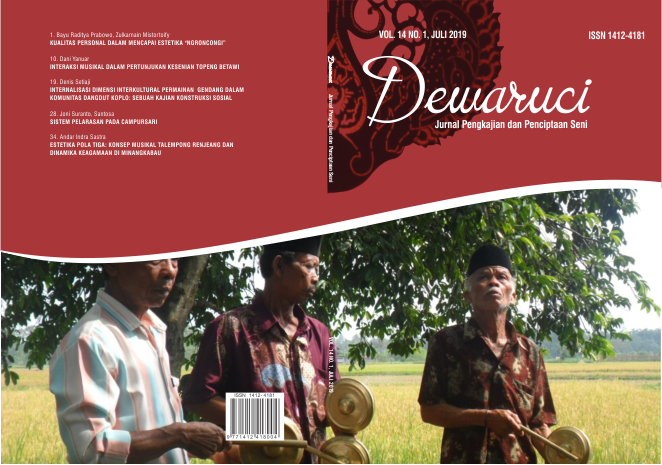Kualitas personal dalam mencapai estetika “Ngroncongi”
DOI:
https://doi.org/10.33153/dewaruci.v14i1.2531Keywords:
Kualitas, Kualitas Personal, Musik Keroncong, The Quality, The Quality of Personal, Keroncong MusicAbstract
Kualitas personal merupakan salah satu komponen pembentuk karakteristik kualitas dalam musik keroncong. Kualitas personal tersebut terbentuk oleh beberapa aspek yang telah meng-embody dalam diri seniman keroncong. Tulisan ini bertujuan untuk mengungkap aspek-aspek beserta operasionalnya dalam membentuk kualitas personal di musik keroncong. Metode penelitian yang digunakan adalah metode kualitatif. Proyeksi tulisan ini akan membahas karakteristik kualitas musik keroncong, dan menggunakan kerangka konseptual yang berasal dari istilah-istilah lokal yang sering digunakan seniman keroncong saat menyajikan pagelaran dalam lingkup musik keroncong. Sebelum mengungkap karakteristik kualitas dalam musik keroncong, penulis akan fokus mengkaji mengenai kualitas personal yang merupakan komponen pembentuk karakteristik kualitas dalam musik keroncong. Kesimpulan penelitian ini adalah kualitas personal dalam musik keroncong terbentuk oleh beberapa aspek yang saling bersinergi, diantaranya akumulasi pengetahuan; kompetensi (skill); interpretasi terhadap lagu keroncong; dan pembawaan secara personal. Beberapa aspek tersebut telah meng-embody dalam diri setiap personal untuk membangun kesadaran secara musikal bahwa musik keroncong menjadi harmonis bukan karena menampilkan virtuositas dari kualitas yang dimiliki oleh setiap personal, melainkan keharmonisan yang tumbuh dari kesadaran ensembleship interpersonal.
ABSTRACT
Personal quality is a component framer of characteristic and quality in keroncong music. The quality of personal was formed by many aspects, who has embodied in the artist of keroncong. This paper aimed to explore the aspect of personal quality includes the operational to form personal quality in keroncong music. The method of research is qualitative and use the framework of local conceptual terminology in scope keroncong music often used by artist keroncong in presenting keroncong music. Before uncovering personal quality, the writer will focus study on the quality of personal in keroncong music. The conclusion in this research is personal quality formed by many aspects with good synergy. They are knowledge, competency (skill), interpretation to song keroncong, and personal character. Some aspect was embodied in every personal to raise musical awareness that keroncong music be harmonious not for showing virtuosity personal, but harmoniously when high awareness of interpersonal ensembles
Downloads
References
Erie Setiawan. Musik Untuk Kehidupan. Yogyakarta: Art Music Today, 2016.
Budiman BJ. Mengenal Keroncong Dari Dekat. Jakarta: 1979.
Edmund Prier SJ, Karl. Kamus Musik. Yogyakarta: Pusat Musik Liturgi, 2014.
Erie Setiawan. Serba-Serbi Intuisi Musikal Dan Yang Alamiah Dari Peristiwa Musik. Yogyakarta: Art Music Today, 2015.
Banoe, Pono. Kamus Musik. Yogyakarta: Percetakan Kanisius, 2003.
Harmunah, S.Mus. Musik Keroncong Sejarah Gaya dan Perkembangan. Yogyakarta: Pusat Musik Liturgi, 1996
Downloads
Published
Issue
Section
License
Authors who publish in Dewa Ruci: Jurnal Pengkajian dan Penciptaan Seni agree to the following terms:
- Authors retain copyright and grant the Dewa Ruci: Jurnal Pengkajian dan Penciptaan Seni right of first publication with the work simultaneously licensed under a Creative Commons Attribution License (CC BY-SA 4.0) that allows others to share (copy and redistribute the material in any medium or format) and adapt (remix, transform, and build upon the material) the work for any purpose, even commercially with an acknowledgment of the work's authorship and initial publication in Dewa Ruci: Jurnal Pengkajian dan Penciptaan Seni.
- Authors are able to enter into separate, additional contractual arrangements for the non-exclusive distribution of the journal's published version of the work (e.g., post it to an institutional repository or publish it in a book), with an acknowledgment of its initial publication in Dewa Ruci: Jurnal Pengkajian dan Penciptaan Seni.
- Authors are permitted and encouraged to post their work online (e.g., in institutional repositories or on their website) prior to and during the submission process, as it can lead to productive exchanges, as well as earlier and greater citation of published work (See The Effect of Open Access).
This work is licensed under a Creative Commons Attribution 4.0 International License












